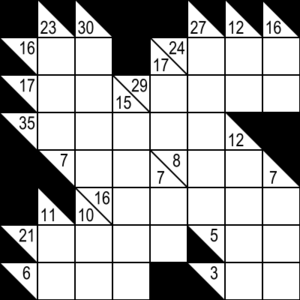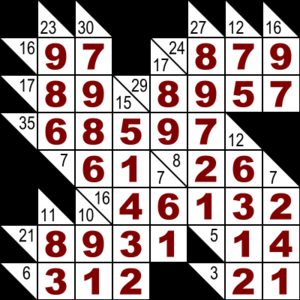Kakuro facts for kids
Kakuro is a fun logic puzzle that many people call a "math crossword." It's a popular puzzle found in many math and logic puzzle books and magazines around the world.
In 1966, a Canadian named Jacob E. Funk first created a puzzle like this. He worked for Dell Magazines and called it Cross Sums. Other names like Cross Addition were also used. But the Japanese name Kakuro became the most popular. It comes from the Japanese words kasan kurosu, which means "addition cross." In Japan, Kakuro is super popular, almost as much as Sudoku! Both puzzles come from a famous company called Nikoli.
A typical Kakuro puzzle uses a grid with black and white cells. The puzzles are often 16x16 squares big, but they can be different sizes. The top row and the far-left column are usually all black. The black cells divide the grid into "entries," which are lines of white cells.
Each black cell has a diagonal line. It also has a number in one or both halves. These numbers are called "clues." For horizontal (side-to-side) entries, the clue is in the black cell to its left. For vertical (up-and-down) entries, the clue is in the black cell right above it.
The goal of Kakuro is to fill each white cell with a number from 1 to 9. Here are the main rules:
- The numbers in each entry must add up to the clue for that entry.
- You cannot use the same number more than once in any single entry. For example, if an entry needs to add up to 4 and has two cells, you can use 1 and 3, but not 2 and 2.
This rule about not repeating numbers is what makes Kakuro puzzles challenging and fun to solve. Just like Sudoku, you need to think about different number combinations to find the solution. A good Kakuro puzzle always has clues that need at least two numbers to add up to them. If a clue only needed one number, it would be too easy!
Some puzzle makers print Kakuro grids like regular crossword puzzles. They number the entries and list the clues separately. This doesn't change how you solve the puzzle, just how it looks.
When people talk about Kakuro puzzles, they often use a shorthand. For example, "16-in-two" means an entry that adds up to 16 and has two cells. If an entry has nine cells and adds up to 45, it's just called "45." This is because an entry with nine cells that doesn't repeat numbers must use all digits from 1 to 9 (1+2+3+4+5+6+7+8+9 = 45).
Contents
How to Solve Kakuro Puzzles
Solving Kakuro is like being a detective! You use logic to figure out which numbers go where.
Using Combinations
Instead of just guessing, a smart way to solve Kakuro is to understand the possible number combinations for different clues and entry lengths. You can narrow down the choices by looking at where horizontal and vertical entries cross.
- Small Clues: Entries with very small or very large clues for their length have fewer possible combinations. For example, a "3-in-two" entry (adds to 3, two cells) can only be 1 and 2. A "4-in-two" entry (adds to 4, two cells) can be 1 and 3.
- Finding Common Numbers: If a "3-in-two" entry crosses a "4-in-two" entry, the cell where they cross must be a "1." Why? Because 1 is the only number they both have in common (1 and 2 for the 3-in-two; 1 and 3 for the 4-in-two).
- Eliminating Possibilities: When you have longer sums, you can find more clues. If a few cells in a sum share possible values, those values can't be used in other cells in that same sum. For example, if two "4-in-two" clues cross a longer sum, and their solutions are 1 and 3, then the 1 and 3 must be in those two specific squares. No other square in that longer sum can use 1 or 3.
- Limited Solution Sets: Some sums have only a few ways to be solved. A "30-in-seven" sum (adds to 30, seven cells) has only two possible sets of numbers: {1,2,3,4,5,6,9} or {1,2,3,4,5,7,8}. If one cell in that sum can only be an 8 or a 9 (because of a crossing clue), then you know which set of numbers to use for the whole sum. This also means no other cell in that sum can be an 8 or a 9.
- Finding Unique Spots: Sometimes, you can figure out where a specific number must go. If a sum needs a certain number (like a "2" in a "36-in-eight" sum, which must contain all digits except 9), and only one cell in that sum can possibly be a "2" (because of its crossing clues), then that cell must be a "2."
Box Technique
The "box technique" is a more advanced trick. It works when you have a group of white cells that form a box shape. By adding up the clues for some horizontal entries and subtracting the clues for some vertical entries that mostly overlap, you can sometimes find the value of a single cell or a small group of cells. This works because addition rules allow you to move numbers around.
Many solvers write small potential numbers in the corners of cells. They erase numbers as they prove them impossible. For very hard puzzles, some people even use graph paper to try out different number combinations before writing them in the puzzle.
Just like with Sudoku, the hardest Kakuro puzzles need even more advanced techniques, often involving looking for patterns.
The Math Behind Kakuro
From a math point of view, Kakuro puzzles are like complex math problems called "integer programming problems." They are also known as "NP-complete," which means they can be very hard to solve quickly as they get bigger.
Popularity of Kakuro
Kakuro puzzles are very popular! They appear in almost 100 Japanese magazines and newspapers. Kakuro was the most popular logic puzzle in Japan until 1992, when Sudoku took its place. In the UK, Kakuro puzzles first appeared in The Guardian, and then in The Telegraph and the Daily Mail.
Different Kinds of Kakuro
There are a few fun variations of Kakuro:
- Cross Products: Instead of adding numbers, you multiply them to reach the clue. Some versions allow numbers to repeat, while others don't.
- Different Number Ranges: Some puzzles use numbers from 1 to 12, instead of just 1 to 9.
- Cross Sums Sudoku: This combines Sudoku and Kakuro. You have a standard 9x9 Sudoku grid, but the clues are given as cross sums.
- Cryptic Kakuro: In this version, the clues are given as word puzzles where each letter stands for a digit from 1 to 9.
See also
 In Spanish: Kakuro para niños
In Spanish: Kakuro para niños



